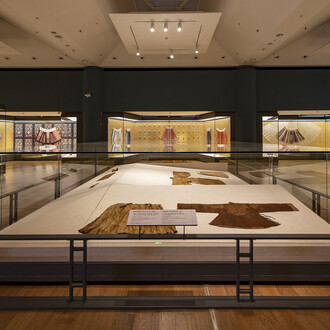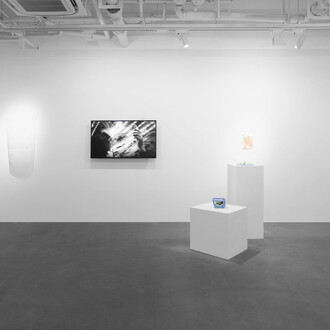Pace Beijing will hold Korean artist Lee Kun-Yong's first solo exhibition in China. Lee is a founder of the Korean avant-garde art group Space and Time (ST), and a leading figure of the group Avant-Garde Association (AG). In the 1960s and 70s, his simple, thought-provoking performance art pieces infused new spiritual energy into a Korean avant-garde art movement then beleaguered on both conceptual and political fronts, and he is called the “father of Korean performance art.”This exhibition will look back ona half-century of the artist’s creative practice through artworks in the mediums of painting, sculpture, video, and site-specific installation.The exhibition will begin with a preview and artist discussion at 3pm on July 14, and open to the public at 4pm.
Beginning with Allan Kaprow's prophetic 1958 essay The Legacy of Jackson Pollock, everyday life has laid itself bare for artists. Lee is doubtless one of the inheritors of this precious legacy. Over a period of five years beginning in 1975, he created roughly fifty performance actions. These works are composed from the basic elements of everyday life, and through repeated performances in various occasion, break the symptomatic “camouflage” of single performance and allow the core of the happening to emerge. In an early representative work, Eating Biscuits, Lee sat upright in front of a table laid with biscuits, each time he ate a biscuit, he would attach a splint to his arm. As the various joints in his arm were fixed in place and prevented from bending, the artist had increasing difficulty successfully eating each biscuit. With a simplicity reminiscent of Samuel Beckett, Lee's artwork directly demonstrated to the audience the kind of predicament to which a limited everyday life can lead. In the repressive political atmosphere of Korea at the time, this series of performances unsurprisingly struck a deep chord, and was quickly disseminated through photography, and even imitated. What’s invaluable of Lee is that he has never emphasized his role as “social activist,” even though it perhaps would have heightened his fame. He has even opposed overly political interpretations of his artworks in order to preserve their openness. For him, the event only manifests as the event itself, while the meaning of the event emerges within the dynamic interplay of the experiences of “I” and “others.” He even once handed out a step-by-step manual to the audiences after a performance and encouraged them to reproduce the performance at home in their own way, thus making the artwork’s authorship open to the public thoroughly.
Eating Biscuits was first performed at the MMCA Seoul in October 1975. Age Counting, shown at the same exhibition, provides another thread for understanding Lee's creations: beginningwith one, the artist counted along to the numbers coming from a speaker, stopping when it reached his age, while the speaker itself kept counting. If the former artwork treated the artist’s own life as an absolute measure of freedom and limitation in individual life, the latter expanded to the external world, by way of juxtaposing individual gradations and the gauge of the world to project the physical world into a call out into the world and mutual affirmation. Two months later, Lee createdthe representative work Logic of Place, which conveyed the worldview glimpsed in Age Countingin a more precise manner: he drew a circle on the ground, then pointed at it, shouting, “there!” He then stepped inside the circle, pointed at his feet, and shouted, “here!” He then stepped out again, pointed back at the circle, and shouted, “there!” Finally, he walked along the circumference of the circle while shouting, “where, where, where” as he gradually disappeared from the audience's view. In this Zen-like simple and vivid performance action, the artist's words echo Western philosophical meditations (Maurice Merleau-Ponty: “There has to be ‘here,’ so there can be ‘there’”) as well as Eastern dialectics (Chuang-tzu: “Other comes out from It, It too adapts to Other”). Meanwhile, the artist’s aggressive gestures and shouts forcibly drew the audience into the performance, the once innocent, removed act of viewing destroyed by the incontrovertible fact of the simultaneous presence. In the end, in the dimensions of the experience of time and space in the performer and each audience member, the relationship between the world and the body is perceived and reaffirmed.
A year later, Lee's everyday performances began to incorporate painting, or, to be more precise, he inserted the act of painting into a series of body motions. In the landmark work Body Drawing 76-01, the artist selected a wood board the same height as himself, and extended his arm around from behind to draw on the front of the board with great difficulty. Once he felt he had drawn on all the surfaces he could physically reach, he sawed off those sections and repeated his initial steps. As the board was continually cut short, the area his hand was able to reach grew larger, and the act of drawing grew increasingly natural. Once the entire board was evenly filled, the artist reattached the pieces in order, restoring this life-sized “painting.” This series of works was originally titled “body representation.” Using the traces left on the board, Lee created “figurative” action paintings in his own way. In the works that followed, the artist would lean back against a canvas, and attempt to stretch his arms behind him and fill in an outline around his body, or use his shoulders as an axis to record the traces of his arms’ rotation. In a sense, when Lee chooses to use his body for creation, the body becomes the key to unlocking every secret. As he has stated before, when the body serves as medium, the inner experience of life becomes connected to the external world. Under the various conditions and limits the artist has set, the body explores its own dimensions through the most basic actions and behaviors, painting a “self-portrait” in the process.
In the essay Artist’s Note, “I believe that I should not expect much from art. Art rises as steam on the surface of water, makes a rainbow in the sun, disappears into the wind, and passes through the subway tunnel to stay amidst people waiting in the platform and sparkle in between their fingers holding a tea cup to disappear.” With his entire artistic career, he has responded to the prophecy Kaprow laid out in The Legacy of Jackson Pollock. Just as Kaprow had hoped, a new generation of artists are becoming the alchemists of their eras, summoning the significance of the ordinary within ordinary things. Sixty years after that essay's release, we find, in the person of a humble practitioner from a neighboring country, a new opportunity to affirm the value of that prophecy.















